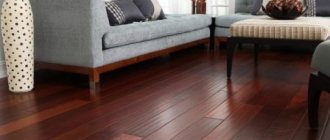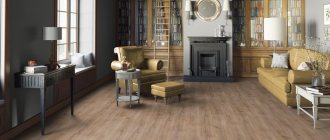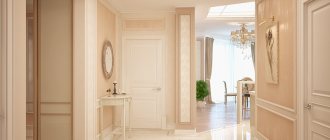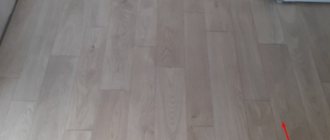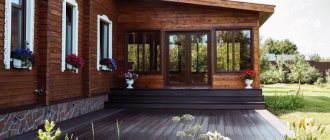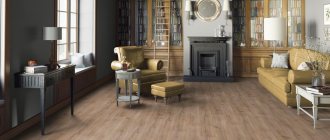Surely for most of us the word “linoleum” does not evoke the best associations. Naturally, because a picture pops up before your eyes: Soviet brown linoleum with an unpresentable seam on a felt backing. Plus, it’s too old, since it’s unlikely that anyone will immediately remember its original appearance.
However, modern linoleum has nothing in common with the Soviet one. And for many designers, such flooring is indeed one of the most convenient, practical and no less attractive materials. We advise you to take a closer look at it.
And yet, which linoleum is better to choose and what do you need to know about it?
Linoleum and its types
Linoleum is a floor covering made from polymer materials. Each type of this material differs not only in characteristics and properties, but also in advantages and disadvantages.
Caring for white linoleum
One of the advantages of white linoleum is that it is easy to clean. To prevent dust from flying around, it is better to vacuum the floor rather than sweep it. Following simple rules for caring for the coating will help not only extend its service life, but also preserve its appearance:
- Do not use hot water for cleaning;
- Bright sunlight will cause the coating to fade;
- Do not dry or ventilate in winter to prevent cracking;
- Do not use abrasive cleaning products when cleaning;
- Do not use detergents containing chlorine;
- When cleaning wet, wring out the cloth well.
It is not recommended to clean the white oak patterned flooring with bleaching agents, otherwise the pattern will be destroyed.
Traces from furniture are clearly visible on a light-colored canvas; this can be avoided by placing wooden plates under the legs. It is advisable to use special care products for coating.
Snow-white Tarquette flooring can be used for various rooms, be it a spacious living room or a small bedroom.
By choosing the right tone and texture, you can get an extraordinary and beautiful floor that you won’t want to hide under a lot of furniture.
Did the article help you? ( 2 ratings, average: 3.00 out of 5)
Classification of modern linoleum
Domestic. This linoleum is distinguished by its affordable price. Able to withstand medium loads.
Commercial. Abrasion resistant and can withstand heavy loads.
Semi-commercial. It has a dense layer and excellent wear resistance. It contains a felt base that retains heat well.
Tips for purchasing linoleum
When choosing linoleum, you should adhere to the basic rules:
- Look at the notations. Each type of coating has its own marking, consisting of two numbers. The first of them means the class of linoleum: 1 - for premises in which traffic is minimal, 2 - household, 3 - semi-commercial, 4 - commercial. The second number indicates the degree of load that the coating can withstand: 1 - minimum, 4 - maximum.
- Pay attention to the smell. Low-quality linoleum with a high content of harmful substances will have a sharp, specific odor and an unhealthy shine (not to be confused with a natural coating that smells of linseed oil).
- Try folding the edge of the cover. On thin, cheap linoleum there will be a mark from the bend, on high-quality linoleum it will return to its original shape, on natural linoleum it will break.
When measuring a room to purchase a certain amount of material, take into account a margin of at least 5 cm, including niches under the radiator, a place near the door, so that the floor covering is not smaller than the room itself.
Regardless of how many rooms you are going to decorate with one type of covering, linoleum should be purchased in one piece. Otherwise, there is a possibility that they may sell you pieces from different batches that differ in color and texture. Don’t forget to ask sellers for quality certificates for products.
When transporting material from the store to the premises, under no circumstances fold it in half - traces of bending will remain. Carefully roll it up with the right side facing inward.
Types of linoleum
Today there is a wide variety of materials:
- Rubber. The front layer of this material is made of rubber, has a lining, the base of which contains crushed rubber and bitumen.
- Alkyd. This type of linoleum is also called glyphthalic. It consists of a fabric base on which an alkyd resin is applied. Contains oils, fillers and pigments.
- Natural has a natural composition, contains tree resin, wood flour, lime and natural pigments to give color.
- PVC has a fabric base and can be multi-layered. It has low thermal conductivity, so it can be cold. But the material is non-toxic and resists the formation of mold and mildew well.
Its performance properties depend on the type of material. The stronger the linoleum, the longer it will delight you with its strong and aesthetic coating.
Types of surfaces.
- Smooth gives the floor a flat surface. Perfectly complements and completes the interior.
- Embossed creates a soft atmosphere in the room. Gives your home a homely feel.
- Matte looks simple but elegant. The light on such a surface is scattered, this allows you to mask minor defects and unevenness of the floor.
- Glossy has an attractive shine and helps to visually expand the room.
Thus, a certain floor covering can create a different atmosphere in the room.
Choosing flooring for your home
The abundance of linoleum options can only complicate the process of choosing a suitable floor covering for private use. Moreover, most modern canvases are heterogeneous and contain substances with different properties. Therefore, a classification system has been adopted to help divide finishing materials into categories and classes depending on the characteristics and appropriate use in residential or public places.
Each class of linoleum is indicated by two code numbers and a pictogram. The first digit in the class designation means the following:
2 – linoleum for residential premises;
3 – covering for office and commercial spaces;
4 – canvas for industrial use.
The second digit in the class marking indicates the level of load that the coating can withstand:
1 – low load;
2 – average;
3 – high;
4 - very high.
Household linoleum
This coating is produced with a class designation from 21 to 23. According to the standards adopted by European manufacturers, such a canvas must have the following characteristics:
- blade thickness from 0.15 to 3 mm;
- specific gravity of the material from 1.25 to 2.25 kg/m2;
- The flexibility and elasticity of the material is checked as follows: when wound on a tube (holder) with a diameter of 45 mm, no cracks should form on the surface;
- sound absorption should be in the range from 13 to 18 dB;
- water absorption of the canvas should not exceed 1-1.5%;
- shrinkage of the coating should not be more than 0.2 mm per meter of surface.
Semi-commercial linoleum
Coatings marked from 31 to 34 are considered semi-commercial. This coating is mainly used in offices, service spaces, commercial premises with low and medium traffic. But, taking into account the small difference in cost and high technological properties, this type of canvas can be used for finishing floors in private apartments - for installation in kitchen and utilitarian spaces (hallways, corridors, floors near stairs).
Semi-commercial linoleum has the following indicators:
- specific weight of the web from 1.6 to 2.5 kg/m2
- sound absorption from 12 to 16 dB;
- shrinkage when used is no more than 0.1 mm per meter;
- flexibility and elasticity must be such that when winding the material onto a rod with a diameter of 10-40 mm, cracks do not form;
- guaranteed service life of at least 7-20 years.
Some tips for purchasing linoleum
When choosing linoleum, you must adhere to the following unspoken rules:
- purchase flooring only in specialized stores, ask for a certificate of conformity and hygiene;
- certified manufacturers always put their logo, linoleum class, batch number on the back of the canvas (if you are planning a mass purchase, then it is necessary that all the canvases be from the same batch; the color may differ by a tone or two) and production date;
- the manufacturer can also apply special pictograms (graphic icons) on the reverse side, signaling the special properties of the canvas - high wear resistance, coating that does not accumulate static electricity, anti-slip surface, easy to care for, double base, enhanced protection of the top layer, high resistance to scratches and abrasion;
- most often, world-famous manufacturers indicate the warranty period for their product;
- it is necessary to select the canvas for finishing the floors in such a way that there are no connecting seams in the room or their number is minimal (due to correct measurement of the area and selection of the appropriate width of the canvas);
- for rooms with a high risk of contamination (hallways), it is better to choose linoleum with a glossy surface;
- When purchasing, you need to inspect the entire linoleum sheet; if you notice a defect after delivering the material and signing the relevant papers, it will not be easy to return the product to the store.
It is also necessary to remember that all your efforts in choosing linoleum and its installation can be ruined by poor surface preparation. If you are not confident in your abilities in the preparatory work and subsequent laying of linoleum, then the best solution would be to turn to specialists.
Pros and cons of linoleum
All finishing materials have their own advantages and disadvantages.
Pros:
- Affordable price.
- Easy installation.
- High heat and sound insulation.
- Moisture resistance.
- Resistant to household products.
- Durable yet soft texture.
- Resistance to deformation.
- Ability to hide uneven surfaces.
Minuses:
- May have a toxic odor.
- At low temperatures it becomes brittle.
- May deform under heavy loads.
A little about coverage
Linoleum is a soft, warm finishing material. It can be natural (made from pine resin, wood flour, linseed oil and lime) and polyvinyl chloride, that is, consisting of PVC and additives. For apartments, household or semi-commercial class coatings are chosen, since commercial linoleum will not justify the costs in this case.
The peculiarity of this material is that it is available in a much richer palette than even the equally popular laminate. These can be plain models, with a pattern, glossy or matte, with or without texture, with imitation wood, brickwork, and much more. etc. Thanks to this, linoleum allows you to solve almost any design problem.
How to choose the right linoleum
For dark rooms, it is optimal to use a coating in light neutral colors. In rooms where there is a lot of sunlight, it is more appropriate to use cool, dark shades.
A linear pattern on the wallpaper will help visually enlarge the room. It can be located on the surface across the walls or diagonally.
The tiled pattern also does a good job of visually expanding the space and gives the coating an interesting look.
Glossy floor - use in design
Glossy linoleum - original and stylish
Gloss gives a chic and prestigious look, does not overload the room, and does not require decoration. Already in itself it is a decoration.
Reflecting the surrounding space, gloss visually enlarges the room. The price for such an original coating is relatively high and not everyone can afford it.
Despite its external vulnerability, the gloss is durable and reliable. Its only drawback is that marks remain on the linoleum, and it must be washed using special products. Some products have additional protection against scratches.
Laying such linoleum with your own hands without damaging it is difficult and it is better to entrust the job to a professional. This is especially true for light shades - they are easy to get dirty during installation work.
Linoleum can be an excellent alternative to laminate. It is stronger and warmer to the touch .
For lovers of natural textures, you can choose flooring that imitates oak or ash. Preference can be given to light colors.
Laminated linoleum is good in this situation - it is more durable and scratches do not appear on its surface longer. It is protected by an additional film, which also adds gloss.
Location of linoleum
There are several ways to place material:
- Floor. This is the most common option. With this method, the floor acquires a smooth and high-quality surface.
- Walls. Sometimes this material is used to decorate the surface of walls. It looks quite original, and also helps keep the room warm during the cold season.
- Doors. Helps hide minor surface defects and insulate it.
- Stair steps. This option gives the room a homey look. For these purposes, it is optimal to use elastic PVC linoleum. In combination with a decorative threshold, the interior becomes complete.
Advantages and disadvantages
A light floor visually expands the space.
Snow-white flooring has the following advantages:
- Visual increase in area;
- Light colors of the coating give the interior nobility;
- Acts as an additional light source, reflecting sunlight and artificial light;
- Plain milky material gives the room spaciousness, lightness and airiness;
- The white board color material will be an excellent backdrop for bright and unusual accessories.
There are no ideal floor coverings; they have not only advantages, but also disadvantages. They need to be studied during interior planning.
The material also has the following disadvantages:
- If there is an excess of light tone in a room, it looks cold and empty;
- On the sunny side the material may turn yellow;
- Any traces, debris, dust are clearly visible.
Keep in mind that when laying white linoleum on the floor, all debris will be visible, as well as traces of tea, coffee or felt-tip pens.
This material is suitable for any room
However, light-colored flooring material has more positive aspects than negative ones. The main thing is to choose the right pattern and texture.
How to choose the color of linoleum
There are several practical tips for choosing:
- For linoleum to look advantageous, it must be darker and more contrasting than other interior items, such as walls and furniture.
- Material in neutral and pastel colors will help harmonize the interior.
- Dark-colored linoleum will complement light-colored furniture and doors.
- In rooms with a small area, the best option would be light-colored linoleum with a glossy surface.
What is better, light or dark linoleum?
A dark floor, unlike a light one, is not universal. It needs to be combined very carefully with other colors and styles. However, at the same time, it gives comfort, unlike white or simply light-colored coatings, and visually slightly reduces the space. As for practicality, dark colors also have disadvantages associated with contamination. Dust, stains, whitish spots, and small debris are visible on dark linoleum. Therefore, it is also not recommended to install it in kitchens, but at the same time it is quite suitable for a corridor, unlike a light one. Wenge is considered a universal dark color for the floor, which looks great in almost all interiors, but is most suitable for classic and modern styles.
Current colors of linoleum
Thanks to the large selection, you can easily decorate a room in any stylistic direction.
Wenge
The wenge color allows you to achieve a certain severity and restraint in the interior, which is especially appropriate for the minimalist style. This range has a rich color palette from dark burgundy to chocolate and almost black.
This linoleum goes well with wood patterns, giving the interior a luxurious, fashionable and modern look.
Green
This multifaceted shade can have a dual effect on a person. Depending on the intensity, it can be both invigorating and relaxing.
But in any case, this color looks very harmonious and helps balance the interior. Green, natural and natural, will be a new trend in the coming year.
Grey colour
Gray is considered a neutral shade and suits almost any interior design. It looks strict and restrained, so it is suitable for any interior style.
Beige color
It is universal, because depending on the shade it can be either cold or warm.
Beige has many shades, for example:
- Sand.
- Caramel.
- Cream.
- Cappuccino.
All shades can differ in intensity and saturation, due to this each time they look new.
Black linoleum
Black is an elegant and strict color. Using it in the interior is always a bold decision. Black may look gloomy, but if you choose the right furniture and other interior elements, it will perfectly harmonize the space and look stylish and original.
Linoleum plays an important and final function in the interior. Therefore, you need to approach his choice responsibly.
Photo gallery (6 pcs.)
From the photographs you can understand what white linoleum looks like in the interior:
Most often it is made in the style of wood and boards, less often it is a monotonous coating.
We offer a comparison with how embossed wood-look linoleum in light and dark shades will look.
Photo of linoleum in the interior
The influence of color on the psyche
There is an undeniable relationship between a person’s mood and color schemes in the interior. Some tones relax, calm, and inspire. Other shades unconsciously instill panic and have an irritating effect on the psyche. Each color stimulates a specific area of the brain and pituitary gland. The latter formation is responsible for the release of hormones that affect metabolic rate, sleep, libido, appetite, and emotional stability. A person depends on what surrounds him. Even a staunch optimist will begin to feel depressed when spending a long time in a room with an abundance of gray and black.
Varieties
Linoleum is distinguished by thickness, protective layer and susceptibility to abrasion. According to these parameters, linoleum is divided into three main categories - household, commercial and semi-commercial:
Articles on the topic (click to view)
- How to choose a floor lamp for your home
- Photo of the interior design of a small living room in an apartment in 2022
- Choosing colors for the room
- Photo of modern interior design with electric fireplace
- Photo of curtain design for the kitchen and living room with two windows
- How to make a mini bar for storing alcohol in the living room
- Built-in wardrobe with TV for the bedroom
- Household linoleum is the most inexpensive option. It is quite thin, but this does not affect the quality of the coating in home spaces, where the load on the floor is not so significant.
- The commercial (or industrial) type of linoleum is most often used in halls that involve large crowds of people, offices, institutional corridors, and shops. The material is the most dense, can withstand maximum loads, is resistant to abrasion and the weight of objects. However, its price is significantly higher, so this type of linoleum is not suitable for an ordinary apartment.
- Semi-commercial linoleum is a cross between household and commercial material. This option will successfully justify itself in the living room of a house, where crowded companies often gather, or in the reception area of the boss’s office.
Imitation of noble coatings
Sometimes, even experts cannot recognize at first glance what kind of coating it is, therefore, in most cases, laminate can be replaced with linoleum without compromising the appearance of the interior. In houses and apartments you can use both household and semi-commercial linoleum.
As you know, commercial, non-commercial and household coating options are available for sale on construction markets. Because Since our site is primarily designed for the renovation of private apartments and houses, we will only consider household linoleums, photos of which are widely presented on this page.
Recommendations for choosing floor colors in different rooms
The right choice of colors for the flooring will allow you to create an individual style in the room and set the right mood.
| Room | Peculiarities | Photo |
| For kitchen. | In order to create a warm, pleasant and family atmosphere in the kitchen, choose linoleum in light brown, dark beige, gray-brown, red-brown or green shades. Also, with the appropriate design of the walls, a floor in moderate blue tones or a darker coating with a pattern that echoes the light stripes would be appropriate. | |
| In the hallway and corridor. | Here, commercial or semi-commercial flooring material in neutral shades is often used, since dirt is less noticeable on them, or a variegated multi-colored speckled coating is used. | |
| For the bathroom. | The choice of shade for linoleum in the bathroom depends entirely on the overall stylistic decision of the room. An excellent solution could be a floor in light green, turquoise, blue, light grey, lavender, yellow or pink. | |
| For the living room. | The most popular colors for the hall are amazing wood shades, for example, bleached oak, walnut, beech, ash, wenge and others are suitable here. | |
| For a children's room. | In children's rooms, coatings in light green, pink, blue and other bright colors are mainly used. |
Which linoleum is better, light or dark?
The choice of tone is determined by personal taste preferences and performance characteristics.
A selection of light linoleum in the interior
Light shades are an excellent light reflector, thereby creating a visual increase in space. This color scheme gives the environment a clean and fresh feel and is especially suitable for decorating bedrooms and living rooms.
The photo shows a bedroom interior with light sand-colored linoleum on the floor.
Linoleum in light or bleached colors not only compensates for the lack of natural light, but also fits perfectly with any furniture, and is also more practical, since dust and stains are less noticeable on it.
Photo of dark linoleum in the apartment
A dark coating gives the design some stability, style and bright contrast, especially if the wall decoration and decorative elements are made in lighter colors. However, this design technique is more suitable for spacious rooms with sufficient natural light, otherwise the interior will look gloomy.
The photo shows a dark brown linoleum floor in the interior of a modern living-dining room.
Dark brown, black flooring or wenge-colored linoleum have a noble appearance and can be an elegant option for a wide variety of rooms, from the bedroom to the office.
The photo shows a spacious kitchen with a floor decorated with dark matte black linoleum.
There are no strict rules when choosing dark or light linoleum, since the color is selected taking into account the comfortable stay in the room, well-being and mood. Dark tones can make someone feel cramped and constricted in space, while too light colors can cause a feeling of coldness and excessive sterility.
Create a discussion on the forum
Do not consider linoleum imitating wood, tiles, stone, etc., as an imitation of these materials. Linoleum is not used as an imitation. It's just his drawing. Very decent flooring. I prefer to use commercial or semi-commercial tarkett for home use. And the price is no cheaper than laminate. Doesn't smell at all.
For lovers of porcelain stoneware, cover it with linoleum. Just put it on top.
In response to the opinion: “And linoleum for apartments is usually too thin, it tears and pierces much more easily than the same Soviet one.”
I thought so too, and then I learned from a consultant that the thinner the linoleum, the more resistant it is to “piercing” and the appearance of holes - the smaller the height difference with “spot” pressure. The secret of strength is in the properties of the protective coating - it should be of the highest quality and thickest possible (but this thickness is millimeter, not centimeter).
It is the thick base that creates the possibility of deformation and tearing from furniture legs and heels. So preference should be given to thin linoleum (but of high quality).
PS In my opinion, the article lacks an analysis of the technical characteristics of different linoleums.
I learned from a consultant that the thinner the linoleum, the more resistant it is to “piercing” and the appearance of holes - the smaller the height difference with “point” pressure.
Consultants will lie about three boxes just to sell the most lame product.
This may be true in theory, but in practice it is quite the opposite.
The thinner and softer the linoleum, the easier it is to pierce through if there is a wooden floor or rough screed underneath it, i.e. in the most typical cases. There is room for a sharp object to go deeper through the linoleum - the wooden floor is pressed through, the screed has irregularities and holes.
Expert opinion
Mikhailova Maria Vasilievna
Furniture store manager. Knows everything about comfort and interior design
And if you pierce the linoleum with furniture, and then try to move the furniture, there will immediately be a tear, a large torn gap in which dirt will collect.
Leaky linoleum will also lose its moisture-protective properties, the wooden floor underneath will begin to rot, moisture easily penetrates there and does not evaporate for a long time.
Soviet linoleum was very hard and over time it hardened even more, turning into hard PVC, because there were no good plasticizers in the USSR. Modern linoleum, on the contrary, only softens over time.
